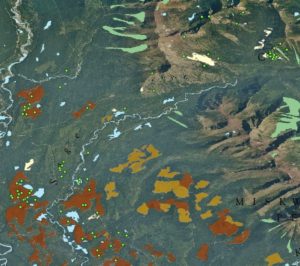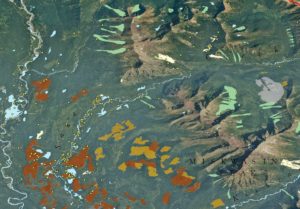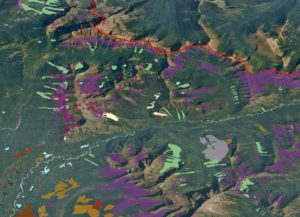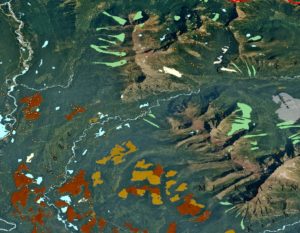Meet Mammie
Mammie was born in 1988 as one of 3 cubs in her litter to Elspeth. Elspeth was very productive, she had at least 17 cubs in her lifetime. In the 1980’s when Mammie was born huckleberries were abundant. When Mammie had her first cub in 1995 huckleberries were abundant however, a 10 year period of low numbers began in 1998. Huckleberries in the Flathead have never returned to the abundance seen in the 1980’s.
When Mammie died in 2016 she had reached the grand old age of 28. Mammie was one of the oldest females we have studied and she had 4 cubs in the time that we followed her. After her first cub Mammie then had 2 more cubs in 2001 who stayed with her until 2004; her fourth and final cub that we know of was born in 2006. The decline in huckleberries probably at least partially explains why she only had 4 cubs in her long life compared to her mother’s 17 although there were a few years when she was not radio-collared so she could have had one or two more young.
Mammie remained in the south Flathead where she was born and where her mother would have showed her what to eat and when it was ready. From 2002 – 2005 Mammie wore a GPS collar which allowed her locations to be extracted from her collar once it was retrieved. We could then see where she was going and, based on what they already knew of the area, guess at what sort of foods she was likely eating. Before then, she wore an old fashioned radio collar that had to be located from an airplane or from the ground using directional antennas. During this earlier period of the study, scientists often watched her and saw what she was doing and feeding on. If she was in thick cover, they went to the site the following day and from the sign present, could tell what she had been feeding on and where she slept. Follow mammie in the maps below and see where she goes between early spring and hibernation over the years from 2002 – 2005. Just like her mother before her Mammie would have been showing her own cubs what to eat and where to find it in these years. One of her cubs, called Tina, dispersed to Alberta where she was killed by a deer hunter near Pincher Creek.
In 2004 and 2005 Mammie left the den during early spring (April 1 – May 15). In this time we see her on high elevation rock and brushland before traveling down to lower elevation. Here, along Sage creek, she can be seen spending time in cut blocks where she likely dug for roots of sweet vetch, and along the riparian corridor where she would find horsetails and grasses as the weather warmed. For the first 2-3 weeks after emerging from the den Mammie was in a state known as walking hibernation where food and water intake is lower than normal activity while her digestive and other unused pathways restart.

In 2002 and 2003 when Mammie’s cubs (called Ike and Tina who were both later collared and followed) were still small she left the den later as is common for mothers with cubs. Like the early spring of later years, Mammie begins at high elevation where her den was located before moving down to lower elevations. On our map you can see that Mammie spends time not only along Sage creek but also along the Flathead river. She is traveling further than the early spring as she has now entered normal activity levels and as more vegetation begins to green-up, forbs would begin to dominate her diet along with grasses and horsetails found in the valley bottoms.
By Early summer (Jul 16 – Aug 15) Mammie has moved on to eat mainly buffaloberries. As she will teach her cubs, buffaloberries are an important food source for bears and are the first berry to ripen of the two major berry species Flathead bears consume in large quantities. While buffaloberry will have formed a large part of Mammie’s diet during July, you can see that she was located often in higher elevation avalanche chutes in Commerce creek where huckleberries are plentiful beginning about August 1. She may have been checking the abundance or ripeness of the huckleberries or, eating forbs in order to mix protien into her sugar rich diet. Most plant parts have more digestible protein than berries.
As late summer (Aug 16 – Sep 15) arrives huckleberries are ripe. During this season the majority of Mammie and her cubs diet was made up of this fruit. However, the abundance of huckleberries wasn’t as great as Mammie remembered as a cub. Nevertheless, she and her cubs would have consumed mass amounts of the berries to build the fat they needed to survive the winter hibernation. Learning to find and eat huckleberries is a key skill the cubs would need to survive when they left their mother.
As fall comes around (Sep 16 – den entry) most huckleberries have been eaten by bears and the rest freeze and fall off the plants. Mammie moved from the huckleberry fields where she can be seen at the beginning of fall to cutblocks at lower elevation. Here she would dig for sweet vetch or Hedysarum roots which form much of a bears diet in the fall. Some forbs could still be found along the river in the riparian corridor but they would no longer be very nutritious. Mammie and her cubs would also have eaten the remains of ungulate carcasses left by hunters. As the weather gets colder towards the end of October and the beginning of November the bears headed up the mountain to select and prepare a den. There they will hibernate together until the beginning of the next spring. The process of selecting and digging a den can take a month as can be seen by the regular movements to high elevation followed by a return to low elevation, presumably to eat.



